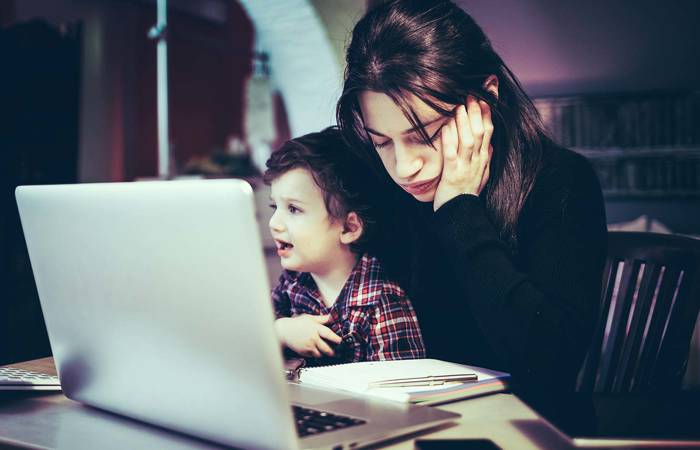Like what you see?
Sign up to receive more free parenting advice.
Thank you for subscribing to our newsletter!
Lifestyle

Credit: iStock.com/jacoblund
In The Superwoman Myth: Can Contemporary Women Have It All Now? The authors ask, "Can women have it all, family, work and everything in between?". If yes, then are these women 'superwomen'? More importantly, what or who is a 'superwoman'?
Jennifer Loh, Raechel Johns and Rebecca English discuss the role of contemporary women in today's modern career world and its myriad of challenges. In turn it explores the nuanced role of millennial women and provides insights into how women juggle demands at home and at work; family and career management. Rebecca English talks about the insights from the work.
Who knows when the family is low on toilet paper and toothpaste? And who’s responsible for the birthday and Christmas shopping in your house? Who’s signing the school notes, who knows when the parent teacher interviews are scheduled? Who remembers what days each child has sport, and which sport? Who knows when to turn up for the music lessons? The concerts? This week’s hockey game? These are all examples of the mental load, and in most households, it’s usually handled by one person… and according to evidence, that’s one person is usually a woman. It’s even more likely to be a woman if you’re in a heterosexual relationship.
We had noticed this pattern in our own busy, professional lives. But, we’d also noticed it among our friends, regardless of their level of education, their job title and the number of hours they worked.
To test whether there really was an issue with the mental load, we interviewed over 200 women for our book, The Superwoman Myth: Can Contemporary Women Have It All Now?. We asked women how they manage balancing work and family and what they thought about ‘juggling it all’.
What is the mental load and how does it play out?
Many of us have read the term ‘mental load’ and know instinctively what it means. But, in addition to its common usage, it also has an academic meaning. In our book, we defined the mental load as knowing what needs to be done, when, and remembering it all.
We were all on tenterhooks before the pandemic with the mental load. But, the 2020 pandemic, particularly for women with children, trying to juggle a job and young children’s schooling at home, made things much worse. We found, in our participants, probably unsurprisingly, COVID increased women’s mental load, not surprisingly most for women with children. This increased mental load had real consequences for women’s mental and physical wellbeing.
We found, as did other people looking into this experience, that men are doing more household tasks than ever before. But that is coming off a low base and researchers have found women are still carrying the mental load in most households. Some of our participants said similar things. Here are some of the quotes received:
In terms of actually DOING the thing (running the vacuum, taking out the trash, folding the laundry, etc) we are probably 70/20, with me doing the majority. In terms of knowing when those things need to be done and being supplied to do them (knowing we are out of clean towels, we need dish detergent etc) more like 95/5 with me in the lead.
I definitely carry about 90% of the mental load, my husband the other 10%, usually about himself. All other tasks, responsibilities to do with our children, dog and household fall to me. In terms of household tasks, it would be 80% me, 15% my husband, 5% my children. I would love them all to do more but they complain and don't do it.
At first my husband chipped in and initiated some household tasks and I was left to do everything else (even when it came to his son). Now my sixty-six year old mother lives with us and she takes on most of the cleaning and laundry. My husband does very little. I want to do more and be more in control of my household but I don't have the energy or time. I take on 100% of the mental load.
Is this a gender issue?
Lazy, sensationalist journalism sees this issue as a male versus female, men-are-from-Mars-women-are-from-Venus issue. But we don’t agree, and it wasn’t backed up in our book.
We found that it was more than gender because we interviewed women in same-sex relationships too. For those women, granted the imbalance was significantly reduced, but still, in most same-sex relationships, the imbalance was still, stubbornly there with one person carrying the ‘mental load’.
So, even while many same-sex coupled women had a more equal allocation of tasks, one person was generally more likely to know what needs to be done, when and how.
This point shows that, even where there are no gendered allocation of tasks (male does the outside work and the heavy work, woman does the caring and cleaning inside) quite obviously because they are both of the same sex, this issue still persisted. In our book, the same-sex participants who reported the worst imbalances were those with children. (Note: One of our authors is in a same-sex relationship).
What about single people?
Single people living on their own are obviously in a different boat, but we also included women in share-housing or group housing in our data.
In that cohort, we found an imbalance in some of the mental load. So, even not being in a committed relationship can’t fix this problem. Someone in the share house was responsible for remembering to pay the bills, for noticing when the fridge was empty and for reminding the tenant in the back room that this was their week to clean the toilet.
Is it workplace participation?
Part of this issue comes from the imbalance in housework not keeping pace with the reality of working women’s lives.
In The Superwoman Myth, we found that, in some extreme cases, a 1960s allocation of household labour was butting up against a 2020s allocation of employment. But, even in the most balanced of households, in most heterosexual families, both partners, whether they had children or not, were in the workforce. So, each adult was contributing to the family’s finances. Our findings reflect the findings of workplace studies which show women’s workforce participation has increased since the 1980s.
And, many of our women were university graduates, reflecting trends that women are, on average, better educated than ever before, and even better educated on average than men.
We’re all doing more than our mothers did. We’re working, we’re still doing the bulk of the housework, and, on average, we are spending more time with our children than our mothers’ did. Interestingly, though are more likely to be present with them, we’re less active to be involved in active play with them.
So, if we’re doing more, why are we still carrying the mental load? No wonder we’re stressed and the pandemic has made it harder.
Alright smarty-pants, what did the book say we should do about it?
The Superwoman Myth suggests, despite government policies and workplace reforms, there doesn’t seem to be a way out of this inequality between men and women.
The issues appear to be stubbornly entrenched. We may have more education, more opportunities and more time in the workforce, but we are still carrying more of the mental load.
Our participants said that the biggest issue was that they hadn’t or didn’t explain their feelings clearly enough to their partners. So, having a discussion in your relationship is essential. It may help to explain the mental load, and discuss ways to balance it more. Your health relies on it!
Strategies for addressing the mental load:
- Talk about the mental load with friends, partners, and people in your workplace
- Both of you should take parental leave if possible, so that you are sharing the load from the start
- Do handover meetings at the end of maternity leave, end of each day, and so on, so that each of you feels empowered to step up
- Be willing to let go and let your partner take charge on some tasks
- Don’t assume your way is better. Your partner’s way may be different, but it still gets done
- When you’re both home with the children, share the load for who is responsible for them, so that you can concentrate on other tasks when you’re ‘off duty’
- Delegate specific tasks and activities including all planning
- Develop a shared plan in advance eg. When planning for a trip, so that you can both step up and work toward the plan
- Organisations should consider the mental load in forms, processes, product design and Government policy. Implement systems to minimise this as much as possible
Source – A number of these recommendations were from Carrell (2019) and The First Five Years (2019).








